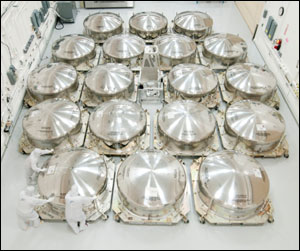
Ball Ships First Webb Telescope Mirrors
The first two mirror assemblies for NASA’s James Webb Space Telescope were delivered last week to Goddard Space Flight Center in Greenbelt, Md., where the telescope is being assembled.
Ball Aerospace & Technologies Corp., under contract to Northrop Grumman, is responsible for the 18 beryllium primary mirror segments that comprise the Webb telescope. The remaining 16 hexagonal mirrors that make up the 6.5 m (21.4 ft) primary mirror will be sent to Goddard over the next 12 months and will be stored until engineers are ready to assemble them for telescope integration in 2015.

(Image: Ball Aerospace)
The first two mirror assemblies “are an important first step leading towards the integration of the mirrors onto the flight structure,” said Lee Feinberg, NASA Optical Telescope Element manager for the Webb.
The telescope, which is on track for an October 2018 liftoff, will be the first civilian space-based observatory to use an actively controlled, segmented mirror architecture. It will study every phase in the history of the universe, ranging from the first luminous glows after the big bang to the formation of stellar systems capable of supporting life on Earth-like planets to the evolution of our own solar system.
Ball Aerospace has made contributions to other astrophysics and planetary missions, including Kepler, the Hubble Space Telescope, the Wide-Field Infrared Survey Explorer, the Spitzer Space Telescope, the Infrared Astronomical Satellite, the Cosmic Background Explorer, the Chandra x-ray observatory and the upcoming Sentinel Mission.
The Webb telescope is a joint project of NASA, the European Space Agency and the Canadian Space Agency.
For more information, visit: www.ball.com
/Buyers_Guide/Ball_Aerospace/c1470
Published: September 2012
Glossary
- photonics
- The technology of generating and harnessing light and other forms of radiant energy whose quantum unit is the photon. The science includes light emission, transmission, deflection, amplification and detection by optical components and instruments, lasers and other light sources, fiber optics, electro-optical instrumentation, related hardware and electronics, and sophisticated systems. The range of applications of photonics extends from energy generation to detection to communications and...
AmericasBall Aerospace & TechnologiesBasic ScienceberylliumBig BangBusinessCanadian Space AgencyChandra X-ray ObservatoryColoradoCosmic Background ExplorerenergyEuropean Space Agencyflight mirrorsGoddard Space Flight CenterHubble Space TelescopeImagingInfrared Astronomical SatelliteJames Webb Space TelescopeKeplerLee FeinbergMarylandmirror systemmirrorsNASANorthrop GrummanOpticsphotonicsprimary mirror segmentssegmented mirror architectureSentinel missionSpitzer Space TelescopeWebb telescopeWide-field Infrared Survey Explorer